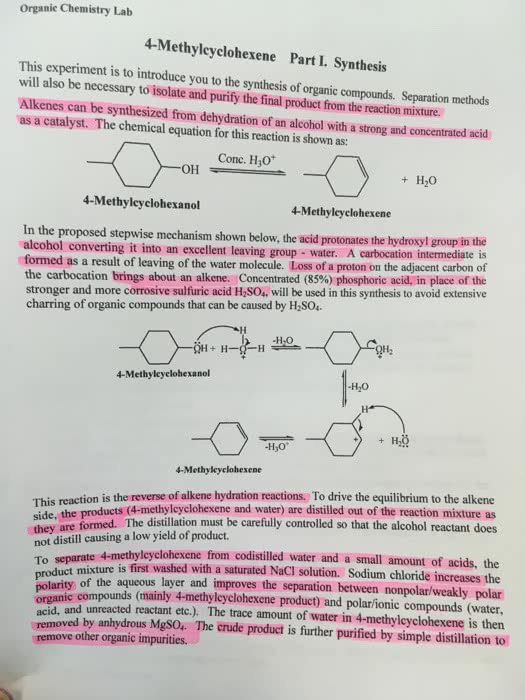CHEM 2152 Lecture Notes - Lecture 6: Nucleophilic Substitution, Organochloride, Steric Effects

The purpose of the experiment was to dehydrate 4-methyl-2-pentanol by an acid
catalyzed elimination reaction to form a mixture of alkenes and verify the product identity
through the bromine and Baeyer tests for unsaturation. In the experiment 4-methyl-2-pentanol
undergoes an E1 elimination to yield product alkenes, as the alcohol is secondary. The hydroxy
group of 4-methyl-2-pentanol is protonated by sulfuric acid to give the oxonium ion, and water
acts as the leaving group. When water leaves, a secondary carbocation is produced, and another
alcohol molecule abstracts a β-hydrogen atom, whose bonding electrons move to form a double
bond between the α-carbon and β-carbon. The secondary carbocation also undergoes 1,2-
hydride shifts to give different secondary carbocations and tertiary carbocations, which are more
stable; these carbocations also undergo deprotonation to yield alkenes. The products of the
reaction are 4-methyl-1-pentene, cis-4-methyl-2-pentene, trans-4-methyl-2-pentene, 2-methyl-1-
pentene, and 2-methyl-2-pentene. A diagram is provided below:
Furthermore, nucleophilic aliphatic substitution reactions (SN1 and SN2) can compete
with elimination reactions, as in E2 reactions, the electrophilic α-carbon atom is subject to attack
by nucleophiles, and in E1 reactions, the carbocation can be trapped by the conjugate base of the
acid catalyst or with another nucleophile such as solvent. In the latter situation, the substitution
side reaction consumes the acid catalyst, so the dehydration may terminate because formation of
some compounds, such as alkyl chlorides, is irreversible under dehydration conditions. Thus, in
the experiment, hydrochloric acid is not used as the catalyst for the dehydration, as the chloride
ion would trap the carbocation to give an alkyl chloride; instead, sulfuric acid is used to affect
the dehydration because the intermediate alkyl bisulfate substitution product readily re-ionizes to
the intermediate carbocation under the reaction conditions. Elimination is favored as substitution
on the α-carbon atom increases because the steric hindrance inhibits direct attack of the base or
find more resources at oneclass.com
find more resources at oneclass.com

nucleophile on the α-carbon atom. Therefore, when the α-carbon is tertiary, elimination is
usually the only reaction that takes place.
To favor these products, Le Chatelier principle must be used because reversal of the
dehydration may be avoided by removing the alkene from the reaction (through fractional
distillation, as its boiling point is lower than that of its parent alcohol) to shift the equilibrium to
the right, in favor of the product alkenes. This can be described in further detail by the equation
K= [Alkene][H20]/[Alcohol]. Using Le Chatelier principle, which states that if a chemical system
at equilibrium experiences a change in concentration, temperature, volume, or total pressure, the
equilibrium will shift in order to minimize the change, if we decrease the amount of H20, we will
get an increase I the amount of Alkene. The specific process of distillation that is described
above is called Azeotropic distillation, which is a method of separating mixtures based on
differences in their volatilities in a boiling liquid mixture. In this process the lower boiling point
will separate. The 4-methyl-2-pentanol has a boiling point of 130 degrees and the alkene isomers
have boiling points lower than 70 degrees. The reason for the difference in boiling points has to
do with the structure of 4-methyl-2-pentanol. Because of the R-O-H group has the capability of
Hydrogen bonding, the alcohol has greater intermolecular forces and needs more heat for the
bonds to be broken.
In the end of the experiment, observing that the fraction that is left after simple
distillation has a boiling point between 53 and 69 degrees Celsius tells us that the mixture of
products contained the desired products. In the results, the boiling point was found to be around
54 degrees Celsius, and the reason this observation is important quantitatively is because the
products of 4-methyl-1-pentene, cis-4-methyl-2-pentene, trans-4-methyl-2-pentene, 2-methyl-1-
pentene, and 2-methyl-2-pentene, have boiling points of 53.9, 56.4, 58.6, 61, and 67.3 degrees
find more resources at oneclass.com
find more resources at oneclass.com
Document Summary
The purpose of the experiment was to dehydrate 4-methyl-2-pentanol by an acid catalyzed elimination reaction to form a mixture of alkenes and verify the product identity through the bromine and baeyer tests for unsaturation. In the experiment 4-methyl-2-pentanol undergoes an e1 elimination to yield product alkenes, as the alcohol is secondary. The hydroxy group of 4-methyl-2-pentanol is protonated by sulfuric acid to give the oxonium ion, and water acts as the leaving group. When water leaves, a secondary carbocation is produced, and another alcohol molecule abstracts a -hydrogen atom, whose bonding electrons move to form a double bond between the -carbon and -carbon. The secondary carbocation also undergoes 1,2- hydride shifts to give different secondary carbocations and tertiary carbocations, which are more stable; these carbocations also undergo deprotonation to yield alkenes. The products of the reaction are 4-methyl-1-pentene, cis-4-methyl-2-pentene, trans-4-methyl-2-pentene, 2-methyl-1- pentene, and 2-methyl-2-pentene.



